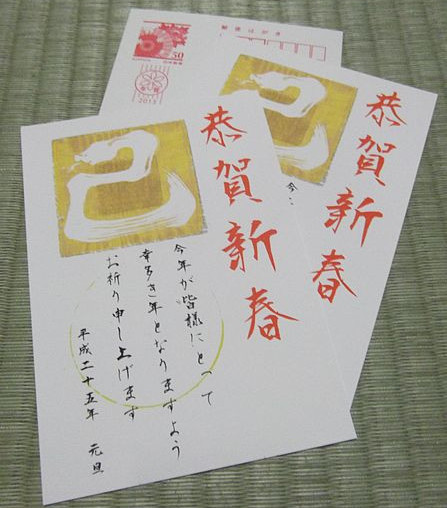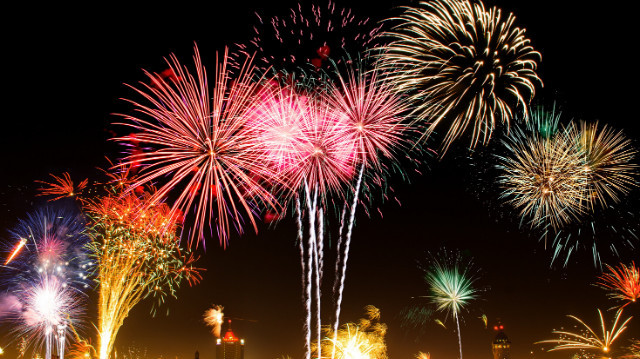The new year is one holiday that we all pretty much celebrate together. Sometimes we had a good year, and sometimes a not so good year. Either way, it’s nice to put it behind us and start fresh. So, how do you say happy new year in Japanese?
There are a couple of phrases, and quite a few abbreviations of said phrases, so we’ll go over all of those first.
After than, we’ll talk about some of the traditions and cultural norms that Japanese people do so that you can join in if you’re in Japan during this holiday.
Happy New Year In Japanese
The first thing to know is that there is a phrase that you use before the clock strikes midnight and there is a different phrase to use after the new year has started.
The phrase that you want to use while it’s still December 31st is the following:
- 良いお年をお迎えください!
- yoi o-toshi o o-mukae kudasai!
- Have a happy New Year!
This would translate literally like “please welcome the new year” that’s coming.
This is the complete phrase, but it’s also seen as being a little formal. If you are with people that you’re close to then you can use the common abbreviation instead.
- 良いお年を!
- yoi o-toshi o!
- Happy New Year!
Then once the old year ends and the new one begins, you will use a different phrase to tell people happy new year.
- 明けましておめでとうございます!
- akemashite omedetou gozaimasu!
- Happy New Year!
This phrase is used to congratulate people on “dawning” of a new year.
As you can tell from the sheer length of the phrase, it’s pretty formal. There are a couple of ways to shorten it to make it more casual for those times you say it to friends or family.
One way it to just drop the ございます and only say 明けましておめでとう!
Another way is the contraction 明けおめ (ake ome) which takes the first two mora from each word.
Once you have used this phrase, it’s common to follow it up with the following:
- 今年もよろしくお願いします!
- kotoshi mo yoroshiku onegai shimasu!
- Have a great year!
This phrase literally says something along the lines of “I look forward to our relationship this year too” which might sound a little awkward in English. That’s probably why most dictionaries just list it as another way to say “Happy New Year.”
Of course this phrase can also be shortened similarly to the last one. All you have to do is drop the お願いします part and instead say 今年もよろしく.
And again, there is a nice contraction for it which is ことよろ (koto yoro). Just like the last contraction, this one takes the first two mora from each word.
With these two short words, you can take the super long phrase:
- 明けましておめでとうございます!今年もよろしくお願いします!
And shortened it to just:
- あけおめことよろ!
Just be sure to only use the short version with people you’re close to.
New Year’s Cards
Interestingly enough, the New Year is considered the most important Japanese holiday. Perhaps it has something to do with the historical fact that all Japanese people used to celebrate their birthdays together at this time.
At any rate, one of the customs of Japan is to send out New Year’s Cards called 年賀状 (nengajou) to their friends, family, co-workers, and anyone else who they feel 義理 (giri) or a “social obligation” towards.
Typically these cards will have the zodiac animal on them for whichever year it is.

[Image Credit: Halowand]
New Year’s Traditions
Like all countries, Japan has its own traditions when it comes to celebrating the New Year.
One of them is eating 年越しそば (toshi koshi soba) which are noodles that they eat during 大晦日 (oomisoka) or New Year’s Eve, as a way of celebrating the passing of the year.
They also like to throw a 忘年会 (bounenkai) which is a “year forgetting party” as a way to let all the things from the last year fall away and prepare for a fresh start.
Another thing that they do, which almost everyone does, is light up the night sky with 花火 (hanabi) which I’m sure you’ve guessed is fireworks.
The difference is that many people say Japan’s fireworks are the best in the world. They have many more colors, shapes, and effects than the typical fireworks one might see in their town.
Have you seen them before? What are your thoughts on them?
Then we flip things over to 元日 (ganjitsu) which is New Year’s Day (January 1st) and the Japanese people do 初詣 (hatsu moude) which is the “first shrine visit of the new year.”
This has to do with the dominant religion in Japan 神道 (shintou) Shintoism. That being said, some people decide to visit a Buddhist temple instead, since Buddhism 仏教 (bukkyou) is the second largest religion in the country.
Shopping During The Holiday
The New Year in Japan is called お正月 (o-shougatsu) and it actually extends from January 1st to January 3rd.
They get more days off than us! What the heck!
During this time most businesses in Japan are shut down and people are spending time with their family and attending events like 初詣.
And get this, kids typically get money from their relatives! It’s called お年玉 (o-toshi dama) and although it doesn’t have to be money, it generally is due to the utility of money and the ability to easily count the value of the gift.
Some of them will decide to spend it on a charm お守り (o-mamori) to protect them or bring them good luck in the new year.
They may also get a Daruma Doll in order to set a new goal that they wish to accomplish before the new year ends.
New Year’s Resolution?
Do you make New Year’s resolution’s to do things like lose weight, get a new job, or have a better relationship?
Most people make some kind of resolution that they’d like to accomplish in the upcoming year, and a common one for readers of this blog would probably be improving their Japanese skills in some capacity.
If one of your resolutions is to become better at Japanese, then check out the top courses for this year to see how you can do it.
Further Resources for Learning Japanese:
#3 Get My eBook (Secrets to Learning Japanese) for Free

またね!

Certainly these phrases seem really easy to learn for the new year. My friend’s son is fascinated with the Japanese language and always want to learn it. I am sure he will find this post helpful, so I will bookmark and share. Do the letters have the same English pronunciation?
The letters have mostly the same pronunciation as they would in English, but there are a couple of rules about it that you should know beforehand. I’ve written about them all in a free course called “The Sounds of Japanese.” You can easily find it by looking in the menu of this blog.
Oh my goodness, you make Japanese seem so simple! I lived with a Japanese girl for a year, and she was always trying to teach me Japanese phrases, and feed me Japanese food. But being that she also lived in America for a while I can’t say any of her traditions were specifically Japanese, like eating Mac and Cheese with chopsticks, pretty sure that was her own created tradition. But I think your site is awesome! Will definitely try and remember some of those phrases and give my old roomie a call this year to impress her. Thanks! Oh, by the way, what is in the Toshikoshi dish?
Hey that is super cool to have a Japanese roommate! I have to admit though, I’ve never heard of eating Mac and Cheese with chopsticks, lol.
Oh you know, a typical toshikoshi soba is made in like a mirin and soysouce soup with some spring onions and maybe some other garnishes. I’ve heard it’s great with duck!